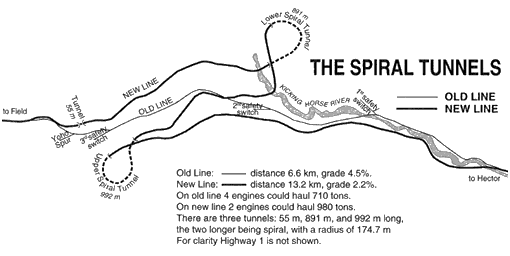
3 June 2009
Spiral Tunnels Centennial Celebration Set

 Field British Columbia - A century ago, Canadian
Pacific Railway engineer John Edward Schwitzer set out to solve the problems of the Big Hill with its steep grade and the
ever-present risk of runaway trains.
Field British Columbia - A century ago, Canadian
Pacific Railway engineer John Edward Schwitzer set out to solve the problems of the Big Hill with its steep grade and the
ever-present risk of runaway trains.
Schwitzer's remarkable plan - the Spiral Tunnels - solved those issues with equally remarkable precision.
It was an engineering feat that, 100 years later, is still an important part of the Canadian Pacific Railway and a highlight in
Canadian identity and the Rocky Mountains.
"Certainly it has done a lot to enhance our operations, the use of these tunnels, in terms of safety and economics and ability.
It continues to be an important part of our network and one that we are very proud of in our company and one that we continue to use
today and will into the future," Breanne Feigel, a Canadian Pacific spokesperson, said Tuesday.
Given its importance and uniqueness, CPR, Parks Canada, and the Friends of Yoho National Park, are ready to launch a series of events
to celebrate the Spiral Tunnels centennial - alongside the centennial of the discovery of the fossils of the Burgess Shale - with
events scheduled throughout the summer, culminating with a 5 Sep 2009 event that will also include a Burgess Shale
component.
The CPR built its tracks through the Kicking Horse Pass in 1884 on a "cheap and steep" philosophy given the challenging
geography and the need to finish the railway quickly. As a result, railway surveyors could only achieve a grade of 4.5 percent.
The cheap and steep option was meant as a temporary solution, but it was one that would be used for 25 years, according to Parks
Canada, even though the first train over the hill lost control and crashed, killing three men.
To keep trains from careening off the tracks, the railway installed three switches that would lead runaway trains onto short steep
spur lines. As trains crested the hill and began the descent, engineers would signal switchmen - four blasts of the whistle meant the
train was in control and the engineer wanted the main line.
But even with the switches in place, trains still derailed, as the system was not foolproof.
A new switchman caused Engine 314 to derail in January 1889. The locomotive engineers, running late, began descending the Big Hill too
quickly. They managed to keep the train under control past the first two switches, but by the third switch, they had lost control.
The switchman, who had been having a nap, woke up and threw the switch, certain he had heard four whistle blasts.
With burning brakes and skidding wheels, the runaway train jumped the tracks and crashed into a cliff. The brakeman and fireman were
killed.
Eastbound trains faced the problem of weight. Pusher engines were required to help trains climb the 4.5 percent grade, which not only
caused considerable delays, but required the CPR to store extra locomotives and workers in Field.
Development of the Spiral Tunnels, however, ended the need for the switches and pusher locomotives.
Completed in 1909, the tunnels, modeled after the Baischina Gorge tunnels of the St. Gotthard Railway in Switzerland, according to
Parks, reduced the grade to 2.2 percent. But to accomplish that required the labour of 1,000 men working 10-hour days,
all for $2.25 a day.
Their effort created the two tunnels, 686,000 cubic metres of excavated rock, and the detonation during the two-year
project of 700,000 kilograms of dynamite.
Schwitzer's plans, which called for a tunnel on either side of the narrow valley of the Kicking Horse Pass, were so well surveyed and
drafted that the final alignment of the entire system was only five centimetres out.
An eastbound train climbing the Kicking Horse Pass enters the 891-metre long Lower Spiral Tunnel, located in Mt. Ogden
and gains 15 metres as it loops around to the left. It then crosses the valley and enters the 991m Upper Spiral Tunnel under Cathedral
Mountain, gaining an additional 17 metres.
Ken Schroeder, Parks Canada spokesperson, said the Spiral Tunnel centennial celebration is relevant to all Canadians as the railway
led to the creation of Canada, as we know it today.
"The railroad was completed as part of the development of Canada and it was the first transportation corridor. When the
Trans-Canada Highway was built, it followed through and uses the same area, so what started out as, we have to connect
Canada, is still 125 years later, going strong," he said.
"We still have Canada, and a railroad, and we now have a major highway, and it all started with this development and the spiral
tunnels are part of the corridor transportation history.
"Everything ties back to the railroad."
As part of the centennial celebrations, Feigel said there might be an opportunity to ride a train through the Spiral Tunnels. However,
at this point, she said the details are still being worked out.
For more information contact the information centre in Field at 1-800-759-2429.
Rob Alexander.
|
|